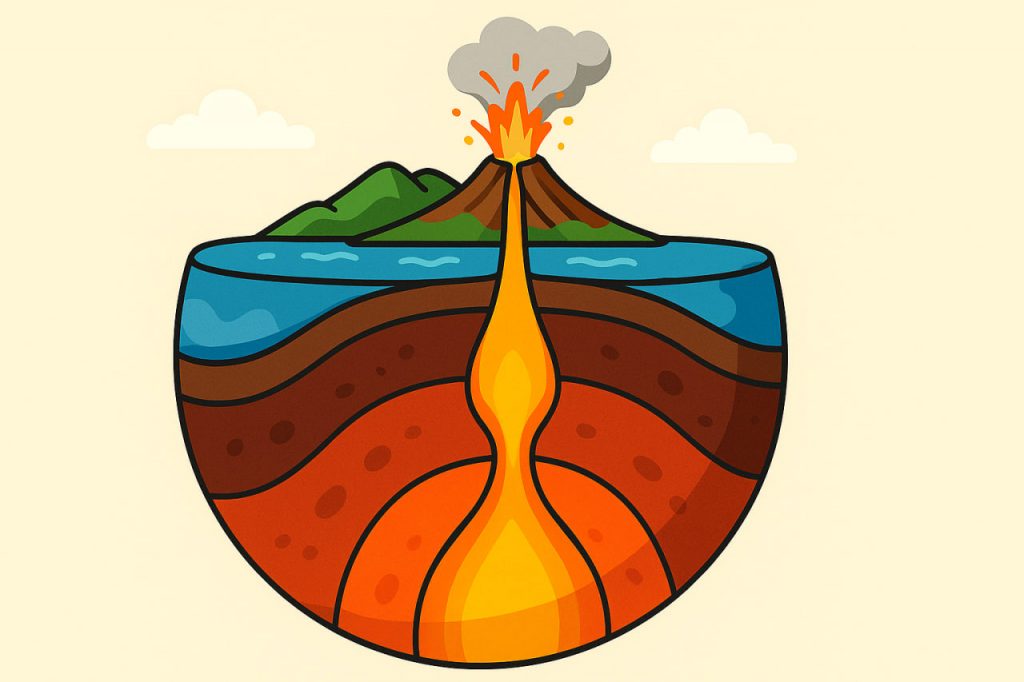A mantle plume is a column of hot, solid rock rising from deep within the Earth’s mantle toward the surface. Unlike processes driven by tectonic plates, mantle plumes originate from great depths, possibly near the core–mantle boundary, and deliver heat and material upward.
How Mantle Plumes Form
Mantle plumes are believed to form when thermal instabilities develop in the lower mantle. These hot regions are less dense than surrounding material, so they rise slowly, carrying enormous amounts of energy toward the lithosphere.
Surface Expression of Mantle Plumes
When a mantle plume reaches the lithosphere, it can cause intense volcanism. The head of the plume may create large volcanic plateaus or flood basalts, while the narrow plume tail can feed chains of volcanoes. A famous example is the Hawaiian Islands, formed as the Pacific Plate moved over a stationary mantle plume.
Geological Significance
Mantle plumes provide a mechanism for explaining volcanic activity far from tectonic plate boundaries. They also help scientists understand how Earth’s internal heat is released and redistributed over time, contributing to the evolution of the planet’s surface.
Evidence for Mantle Plumes
- Hotspot volcanoes such as Hawaii, Iceland, and Yellowstone.
- Seismic tomography images showing vertical structures in the mantle.
- Geological records of massive volcanic events, such as the Siberian Traps, linked to plume activity.
Alternative Theories
Not all scientists agree on the mantle plume hypothesis. Some propose that surface volcanism may result from lithospheric stretching or other shallow processes rather than deep mantle sources. However, mantle plume theory remains the most widely accepted explanation.
Conclusion
Mantle plumes are deep, powerful upwellings of heat and rock that shape the Earth’s surface through volcanic activity. They play a key role in Earth’s internal dynamics and in forming some of the planet’s most dramatic geological features.
Interesting Facts
A mantle plume is a massive column of hot, buoyant rock rising from deep within Earth’s mantle, possibly originating near the core–mantle boundary, about 2,900 kilometers below the surface. As the plume ascends, pressure decreases and the rock begins to partially melt, creating magma that can form volcanoes, island chains, or large igneous provinces. Famous examples include Hawaii, Iceland, and the Yellowstone hotspot, all believed to be surface expressions of active plumes. Unlike plate-boundary volcanism, plume activity can occur in the middle of tectonic plates, which is why Hawaii’s volcanoes rise from the center of the Pacific Plate. Interestingly, mantle plumes may be thousands of kilometers wide at their base but narrow to just 100 kilometers near the crust. Modern seismic imaging and supercomputer models suggest they play a crucial role in heat transfer, continental breakup, and even mass extinctions when enormous volcanic outpourings alter global climate. Mantle plumes are thus a key driver of Earth’s deep internal dynamics.
Glossary
- Mantle plume – rising column of hot rock from Earth’s mantle.
- Core–mantle boundary – the layer between Earth’s outer core and mantle.
- Lithosphere – the rigid outer layer of Earth, including crust and upper mantle.
- Hotspot – volcanic region thought to be fed by a mantle plume.
- Flood basalts – vast volcanic plateaus created by plume activity.
- Seismic tomography – imaging technique using seismic waves to study Earth’s interior.


